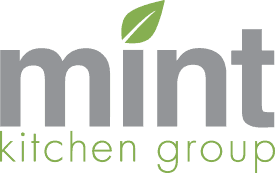When designing a new kitchen or bathroom, your choice of cabinetry finish is one of the most important decisions you’ll need to make. Cabinetry finishes can vary significantly in terms of aesthetics, durability and cost, so it’s important to weigh up the pros and cons of each option before making your final selection.
One popular option is 2 pac finish—but what is 2 pac and how does it compare to the alternatives? Here we’ll fill you in on everything you need to know so you can make the right choice for your new space.
What is 2 Pac Finish?
Cabinetry with 2 pac finish is typically constructed from a substrate material such as medium density fibreboard (MDF) which is sprayed with 2 pac polyurethane paint. 2 pac paint includes a hardening agent, that when cured, produces a finish similar to what you see on motor vehicles, making it very hard-wearing.
As the paint is sprayed onto the cabinetry surface, 2 pac paint can be used for both flat and profiled cabinetry styles in your choice of a textured, matt, satin, semi-gloss or high-gloss finish. The colour options are infinite and edges will appear smooth and seamless.
The main disadvantage of 2 pac cabinetry is that even while it is very hard-wearing, it can be prone to chipping and scratches.
What Are the Alternatives to 2 Pac Polyurethane?
While 2 Pac finish is a popular option, there is a variety of other finishes you might want to consider, including:
- Laminate: Layers of resin-coated, phenolic-backed paper is printed and glued/laminated to a substrate material such as MDF or plywood using high-pressure machinery.
- Vinyl Wrap: Sheets of vinyl are heated, wrapped and sealed around all sides of an MDF substrate.
- Acrylic: All sides of the substrate material is laminated with a cold pressed acrylic foil.
- Timber Veneer: Thin strips of natural wood are glued to the substrate material to achieve the look and feel of solid timber.
How do the various types of cabinetry finishes compare?
The following table provides and overview of the key pros and cons of each cabinetry finish option.
| Pros | Cons | |
| Laminate | ● Affordable
● Durable ● Extensive colour and design options |
● Edging may be visible |
| Vinyl wrap | ● Suitable for all door profiles
● No visible edging |
● May not perform well with heat and moisture
● Difficult to repair if damaged |
| Acrylic | ● Durable
● Great for high gloss ● UV resistant ● More affordable than 2 pac and timber veneer |
● More expensive than laminate
● Edging may be visible ● Susceptible to scratches |
| 2 Pac Polyurethane | ● Durable
● Multiple finish options ● Endless colour options ● UV, heat and moisture resistant ● Suitable for both flat and shaped door profiles ● Smooth/seamless edges |
● Prone to chipping
● One of the most expensive options ● Longer manufacturing lead-time |
| Timber Veneer | ● Durable
● UV and moisture resistant ● Looks like solid timber ● More affordable than solid timber |
● Top end of the price scale |
Expert Advice to Guide Your Design Decisions
When you choose Mint Kitchens, our expert designers will work closely with you to help you weigh up the various design options to create a space of distinction that meets (and hopefully exceeds) your expectations.
Find out more about what we can do or book a tour of one of our Melbourne showrooms to experience the Mint difference.






Leave a Reply